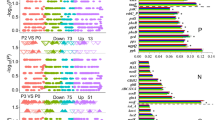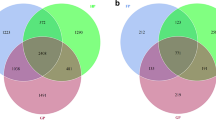Abstract
The study of the rhizosphere microbial community in salinized soils aids in the elucidation of new and important microbial functional groups, which is of great importance in vegetation restoration and ecological reconstruction of salinized soil. The rhizosphere soil bacterial diversity and community structures of four halophytes, including Kalidium foliatum, Lycium ruthenicum, Karelinia caspia and Phragmites australis, typically distributed in the saline-alkaline land of Southern Xinjiang, China, were studied using an Illumina paired-end sequence platform. The study aims to reveal the alpha diversity, species composition, abundance and the differences of rhizosphere bacteria among the four halophytes, explore their correlation with environmental factors. The results showed that the highest bacterial species diversity was associated with P. communis, followed by K. foliatum, K. caspia, and L. ruthenicum. The species richness was the lowest for L. ruthenicum, while the others showed no significant difference. Firmicutes, Proteobacteria, Actinobacteria and Bacteroidetes were the most dominant phyla. And Bacillus and Halomonas were the most common dominant genera. The bacterial communities associated with K. foliatum and K. caspia were similar, while that of L. ruthenicum was significantly different from other halophytes. Soil total nitrogen and total phosphorus, soil organic matter, soil water content, electronic conductivity and pH were identified as the key factors affecting bacterial abundance associated with the assayed halophytes. These results indicate that the four halophytes evaluated in the present study have a similar rhizosphere bacterial community structure due to their being in the same region. However, the bacterial abundance is different among the plant species, and soil properties are the important factors driving the structures of bacterial communities.





Similar content being viewed by others
Data Availability
The data sets supporting the results of this article are included within the article and its additional files.
References
Ma JB, Zhang MR, Xiao XL, You JJ, Wang JR, Wang T, Yao YN, Tian CY (2013) Global transcriptome profiling of Salicornia europaea L. shoots under NaCl treatment. PLoS ONE 8:e65877. https://doi.org/10.1371/journal.pone.0065877
Flowers TJ, Colmer TD (2015) Plant salt tolerance: adaptations in halophytes. Ann Bot-London 115:327–331
Mora-Ruiz MD, Alejandre-Colomo C, Ledger T, Gonzalez B, Orfila A, Rossello-Mora R (2018) Non-halophilic endophytes associated with the euhalophyte Arthrocnemum macrostachyum and their plant growth promoting activity potential. Fems Microbiol Lett 365:fny208. https://doi.org/10.1093/femsle/fny208
Bouchhima RA, Sarti M, Ciolfi M, Lauteri M, Ksibi M (2018) Decision tree for mapping of halophyte cover around Ghannouch, Tunisia. Environ Monit Assess 190:742. https://doi.org/10.1007/s10661-018-7115-3
Sengupta S, Mangu V, Sanchez L, Bedre R, Joshi R, Rajasekaran K, Baisakh N (2019) An actin-depolymerizing factor from the halophyte smooth cordgrass, Spartina alterniflora (SaADF2), is superior to its rice homolog (OsADF2) in conferring drought and salt tolerance when constitutively overexpressed in rice. Plant Biotechnol J 17:188–205
Mahoney AK, Yin CT, Hulbert SH (2017) Community structure, species variation, and potential functions of rhizosphere-associated bacteria of different winter wheat (Triticum aestivum) cultivars. Front Plant Sci 8:132. https://doi.org/10.3389/fpls.2017.00132
Raaijmakers JM, Mazzola M (2016) Soil immune responses soil microbiomes may be harnessed for plant health. Science 352:1392–1393
Kearl J, McNary C, Lowman JS, Mei CS, Aanderud ZT, Smith ST, West J, Colton E, Hamson M, Nielsen BL (2019) Salt-tolerant halophyte rhizosphere bacteria stimulate growth of alfalfa in salty soil. Front Microbiol 10:1849. https://doi.org/10.3389/fmicb.2019.01849
Palacio-Rodriguez R, Coria-Arellano JL, Lopez-Bucio J, Sanchez-Salas J, Muro-Perez G, Castaneda-Gaytan G, Saenz-Mata J (2017) Halophilic rhizobacteria from Distichlis spicata promote growth and improve salt tolerance in heterologous plant hosts. Symbiosis 73:179–189
Etesami H, Beattie GA (2018) Mining halophytes for plant growth-promoting halotolerant bacteria to enhance the salinity tolerance of non-halophytic crops. Front Microbiol 9:148. https://doi.org/10.3389/fmicb.2018.00148
Numan M, Bashir S, Khan Y, Mumtaz R, Shinwari ZK, Khan AL, Khan A, AL-Harrasi A (2018) Plant growth promoting bacteria as an alternative strategy for salt tolerance in plants: a review. Microbiol Res 209:21–32
Tiepo AN, Hertel MF, Rocha SS, Calzavara AK, De Oliveira ALM, Pimenta JA, Oliveira HC, Bianchini E, Stolf-Moreira R (2018) Enhanced drought tolerance in seedlings of neotropical tree species inoculated with plant growth-promoting bacteria. Plant Physiol Bioch 130:277–288
Sarkar J, Chakraborty B, Chakraborty U (2018) Plant growth promoting rhizobacteria protect wheat plants against temperature stress through antioxidant signalling and reducing chloroplast and membrane injury. J Plant Growth Regul 37:1396–1412
Keswani C, Prakash O, Bharti N, Vilchez JI, Sansinenea E, Lally RD, Borriss R, Singh SP, Gupta VK, Fraceto LF et al (2019) Re-addressing the biosafety issues of plant growth promoting rhizobacteria. Sci Total Environ 690:841–852
Fierer N (2017) Embracing the unknown: disentangling the complexities of the soil microbiome. Nat Rev Microbiol 15:579–590
Xie HT, Yang X, Drury CF, Yang J-Y, Zhang XD (2011) Predicting soil organic carbon and total nitrogen using mid- and near-infrared spectra for brookston clay loam soil in Southwestern Ontario, Canada. Can J Soil Sci 91:53–63
Bao S (2000) Soil agro-chemistrical analysis, 3rd edn. China Agriculture Press, Beijing
Li Y, Yang X, Qin L, Lü G, He X, Zhang X (2018) The bacterial diversity and community structures in rhizosphere soil of two halophytes, Lycium ruthenicum and Kalidium capsicum. Acta Ecol Sin 38:3118–3131 (in Chinese)
Bokulich NA, Subramanian S, Faith JJ, Gevers D, Gordon JI, Knight R, Mills DA, Caporaso JG (2013) Quality-filtering vastly improves diversity estimates from Illumina amplicon sequencing. Nat Methods 10:57–59
Vasileiadis S, Puglisi E, Arena M, Cappa F, Cocconcelli PS, Trevisan M (2012) Soil bacterial diversity screening using single 16S rRNA gene V regions coupled with multi-million read generating sequencing technologies. PLoS ONE 7:e42671. https://doi.org/10.1371/journal.pone.0042671
Hashem A, Tabassum B, Fathi Abd Allah E (2019) Bacillus subtilis: a plant-growth promoting rhizobacterium that also impacts biotic stress. Saudi J Biol Sci 26:1291–1297
Sousa RMS, Mendes LW, Antunes JEL, Oliveira LMD, Sousa AMDB, Gomes RLF, Lopes ACD, Araujo FF, Melo VMM, Araujo ASF (2020) Diversity and structure of bacterial community in rhizosphere of lima bean. Appl Soil Ecol 150:103490. https://doi.org/10.1016/j.apsoil.2019.103490
de Vries FT, Griffiths RI, Knight CG, Nicolitch O, Williams A (2020) Harnessing rhizosphere microbiomes for drought-resilient crop production. Science 368:270–274
Floc’h JB, Hamel C, Harker KN, St-Arnaud M (2020) Fungal communities of the canola rhizosphere: keystone species and substantial between-year variation of the rhizosphere microbiome. Microb Ecol 80:762–777
Yang J, Ma L, Jiang HC, Wu G, Dong HL (2016) Salinity shapes microbial diversity and community structure in surface sediments of the Qinghai-Tibetan Lakes. Sci Rep-Uk 6:25078. https://doi.org/10.1038/srep25078
Gao JL, Luo Y, Wei YL, Huang YL, Zhang H, He WL, Sheng HM, An LZ (2019) Effect of aridity and dune type on rhizosphere soil bacterial communities of Caragana microphylla in desert regions of northern China. PLoS ONE 14:e0224195. https://doi.org/10.1371/journal.pone.0224195
Neilson JW, Quade J, Ortiz M, Nelson WM, Legatzki A, Tian F, LaComb M, Betancourt JL, Wing RA, Soderlund CA et al (2012) Life at the hyperarid margin: novel bacterial diversity in arid soils of the Atacama Desert, Chile. Extremophiles 16:553–566
Johnston-Monje D, Lundberg DS, Lazarovits G, Reis VM, Raizada MN (2016) Bacterial populations in juvenile maize rhizospheres originate from both seed and soil. Plant Soil 405:337–355
Vega-Avila AD, Gumiere T, Andrade PAM, Lima-Perim JE, Durrer A, Baigori M, Vazquez F, Andreote FD (2015) Bacterial communities in the rhizosphere of Vitis vinifera L. cultivated under distinct agricultural practices in Argentina. Antonie Van Leeuwenhoek 107:575–588
Shi SJ, Nuccio E, Herman DJ, Rijkers R, Estera K, Li JB, da Rocha UN, He ZL, Pett-Ridge J, Brodie EL et al (2015) Successional trajectories of rhizosphere bacterial communities over consecutive seasons. Mbio 6:e00746. https://doi.org/10.1128/mBio.00746-15
Kielak AM, Cipriano MAP, Kuramae EE (2016) Acidobacteria strains from subdivision 1 act as plant growth-promoting bacteria. Arch Microbiol 198:987–993
Williams A, de Vries FT (2020) Plant root exudation under drought: implications for ecosystem functioning. New Phytol 225:1899–1905
Abiala MA, Odebode AC, Hsu SF, Blackwoodb CB (2015) Phytobeneficial properties of bacteria isolated from the rhizosphere of maize in Southwestern Nigerian soils. Appl Environ Microb 81:4736–4743
Vreeland RH, Litchfield CD, Martin EL, Elliot E (1980) Halomonas elongata, a new genus and species of extremely salt-tolerant bacteria. Int J Syst Bacteriol 30:485–495
Yang H, Hu JX, Long XH, Liu ZP, Rengel Z (2016) Salinity altered root distribution and increased diversity of bacterial communities in the rhizosphere soil of Jerusalem artichoke. Sci Rep-Uk 6:20687. https://doi.org/10.1038/srep20687
Ibekwe AM, Poss JA, Grattan SR, Grieve CM, Suarez D (2010) Bacterial diversity in cucumber (Cucumis sativus) rhizosphere in response to salinity, soil pH, and boron. Soil Biol Biochem 42:567–575
Bencherif K, Boutekrabt A, Fontaine J, Laruelle F, Dalpe Y, Sahraoui ALH (2015) Impact of soil salinity on arbuscular mycorrhizal fungi biodiversity and microflora biomass associated with Tamarix articulata Vahll rhizosphere in arid and semi-arid Algerian areas. Sci Total Environ 533:488–494
Nie M, Zhang X, Wang J, Jiang L, Yang J, Quan Z, Cui X, Fang C, Li B (2009) Rhizosphere effects on soil bacterial abundance and diversity in the Yellow River Deltaic ecosystem as influenced by petroleum contamination and soil salinization. Soil Biol Biochem 41:2535–2542
Li F, Hu H (2005) Isolation and characterization of a novel antialgal allelochemical from Phragmites communis. Appl Environ Microb 71:6545–6553
Yao YX, Tang HZ, Su F, Xu P (2015) Comparative genome analysis reveals the molecular basis of nicotine degradation and survival capacities of Arthrobacter. Sci Rep-Uk 5:08642. https://doi.org/10.1038/srep08642
Ren L, Jia Y, Ruth N, Shi YH, Wang JH, Qiao C, Yan YC (2016) Biotransformations of bisphenols mediated by a novel Arthrobacter sp strain YC-RL1. Appl Microbiol Biot 100:1967–1976
Safdarian M, Askari H, Shariati JV, Nematzadeh G (2019) Transcriptional responses of wheat roots inoculated with Arthrobacter nitroguajacolicus to salt stress. Sci Rep-Uk 9:651–681
Vanissa TTG, Berger B, Patz S, Becker M, Turečková V, Novák O, Tarkowská D, Henri F, Ruppel S (2020) The response of maize to inoculation with Arthrobacter sp. and Bacillus sp. in phosphorus-deficient, salinity-affected soil. Microorganisms 8:1005. https://doi.org/10.3390/microorganisms8071005
Naylor D, Coleman-Derr D (2018) Drought stress and root-associated bacterial communities. Front Plant Sci 8:02223. https://doi.org/10.3389/fpls.2017.02223
Acknowledgements
This study was supported by grants from the Scientific Research Program of the Higher Education Institution of XinJiang, China (Grant No. XJEDU2018Y038) and the National Key Research and Development Project of China (Grant No. 2019YFC0507703).
Author information
Authors and Affiliations
Contributions
ML and TY designed the experiment, reviewed and edited the manuscript. TZ, QZ and MM carried out the field sampling, JW took part in data analysis and the writing of the manuscript.
Corresponding author
Ethics declarations
Conflict of interest
The authors declare that they have no conflict of interest.
Ethical Approval
This manuscript is an original work and never has been published elsewhere in any form or language.
Additional information
First author: Mingyuan Li
Publisher's Note
Springer Nature remains neutral with regard to jurisdictional claims in published maps and institutional affiliations.
Supplementary Information
Below is the link to the electronic supplementary material.
Rights and permissions
About this article
Cite this article
Li, M., Wang, J., Yao, T. et al. Bacterial Diversity and Community Structure in the Rhizosphere of Four Halophytes. Curr Microbiol 78, 2720–2732 (2021). https://doi.org/10.1007/s00284-021-02536-3
Received:
Accepted:
Published:
Issue Date:
DOI: https://doi.org/10.1007/s00284-021-02536-3




